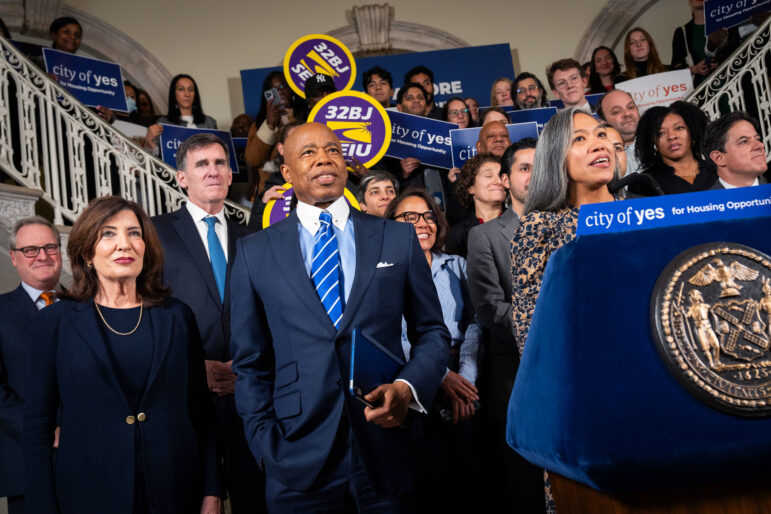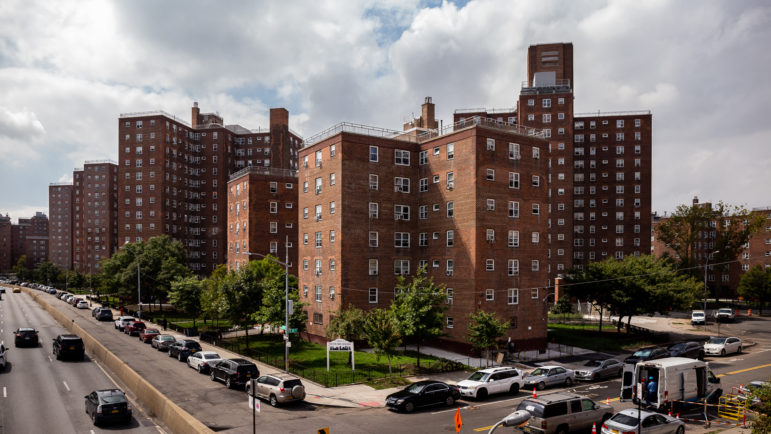“Ballot measures are an opportunity for voters to directly weigh in on policies that affect their day-to-day lives and the future of our state. When incomprehensible ballot language forces voters to cede this opportunity, their voices are effectively silenced.”

Adi Talwar
A voter marking his ballot at the Pelham Parkway Community Center polling station in 2023.Voter suppression does not require intent, and in New York it has often been antiquated laws and complicated bureaucracy that have long deterred our efforts to expand participation in voter enfranchisement
One example of how voters are shut out of the process is around the language on their ballots. New Yorkers have long complained that the wording of statewide ballot measures is difficult to understand, causing many of them not to vote on these questions at all. In 2021, 14 percent of New Yorkers who voted in the election skipped all five measures on the ballot altogether, and even more only answered some of the questions. That’s a problem—people aren’t able to make their voices heard at the ballot box.
Ballot measures are an opportunity for voters to directly weigh in on policies that affect their day-to-day lives and the future of our state. When incomprehensible ballot language forces voters to cede this opportunity, their voices are effectively silenced, and our democracy becomes less representative of the will of the people.
Last year, New York enacted legislation meant to rectify this exact problem and ensure that voters can easily understand what they’re being asked to vote on. Known as the plain language law, it requires all statewide ballot measures be written in “plain language.” Specifically, it calls for language that is at or below an eighth-grade reading level, defined as receiving an Automated Readability Index (ARI) score of no higher than eight.
The November election will be the first with the plain language law in effect. There’s only one statewide measure on the ballot: Proposal 1, which would add an amendment to the State Constitution prohibiting government discrimination on the basis of sex, age, ethnicity, and disability and guaranteeing the right to abortion in New York.
Unfortunately, the Board of Elections has so far failed to adhere to the standards set by the plain language law. In early July, the BOE posted its proposed ballot language for Proposal 1. According to the Board’s own ARI calculation, the text received a score of 14, meaning that someone would need to read at a college-grad level to understand it. That leaves a lot of New York voters behind.
The average ARI score of the 11 ballot measures put to New York voters since 2017 is 14. In other words, the BOE’s proposed language for Proposal 1 isn’t any more readable than what voters saw on their ballots before the enactment of the plain language law. This would be unacceptable.
Fortunately, the BOE still has time to simplify the language for Proposal 1 before it appears before voters in November. It is crucial that they do so. Voters need to understand the important abortion and anti-discrimination protections provided by Proposal 1. And New York needs to show that it is serious about fulfilling the plain language law’s promise to expand voter participation and engagement.
At a time when other states are engaged in active voter suppression, New York has made major progress on strengthening voting rights. The plain language law is a significant piece of that effort. If the BOE doesn’t take seriously its responsibility to follow the law, then voters—and our state—will be left right where we started, with unnecessarily complex ballot language that discourages voter participation.
In stipulating that ballot measures should be written at an eighth-grade reading level, the plain language law is intended to break down barriers to voters making their voices heard. In New York, 3.9 million adults—almost 20 percent of the population—lack English language proficiency, basic literacy, or a high school diploma. The eighth grade reading level standard would make ballot measures accessible to voters from these groups; it would also make it easier to translate the text into languages other than English.
Even voters who read at a more advanced level frequently find themselves confused and intimidated by the convoluted legalese that has historically characterized New York’s ballot measures. You shouldn’t have to have an advanced degree, or be made to puzzle over the meaning of obscure phrasing and terms in the voting booth, in order to confidently cast your vote.
On Proposal 1, there are simple steps the Board should take to lower the ARI score and ensure that the language is both intelligible to all voters and informs them of the amendment’s practical implications.
Despite the fact that Proposal 1 explicitly protects abortion, the BOE’s proposed ballot language does not even include the word “abortion,” opting instead to say the amendment “covers reproductive health and autonomy.” “Abortion” is a word that virtually every voter knows the meaning of, whereas many are unfamiliar with or unclear on the meaning of “reproductive healthcare and autonomy.” Simply adding “abortion” to the Proposal 1 description would dramatically increase the accessibility of the language and guarantee that voters understand that they are being asked to vote on the crucial question of abortion rights.
Similarly, the proposed language uses more obscure language when describing LGBT communities. Rather than “sexual orientation and gender identity,” the board should use the much more understandable “LGBT.” The term “LGBT” allows many more voters to understand exactly what Proposal 1 would do—protect communities who face ongoing discrimination in our state.
Clear, straightforward ballot language serves all voters—and evens the playing field for those who are most likely to be excluded from our democratic processes. Voting is a fundamental right, and we cannot have a true democracy unless voters of every background are able to easily exercise that right.
The BOE must take seriously its responsibility to voters and to the law, make the Proposal 1 language more intelligible, and provide New York with a ballot question that everyone can understand and confidently vote on.
L. Joy Williams is the president of Brooklyn NAACP and the legislative coordinator at the NAACP NYS Conference of Branches.








